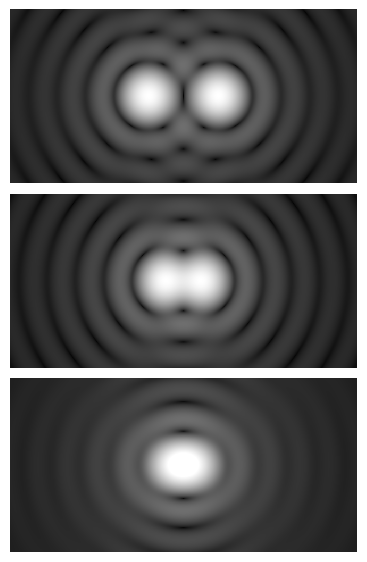
Caption: Two overlapping Airy diffraction patterns (in some optical device with a circular aperture) for two identical monochromatic point light sources at optical infinity separated in angle θ. Going downward in the image, θ goes 2θ_R, θ_R, and (1/2)*θ_R, where θ_R is the Rayleigh criterion.
Features:
-
An example of multiple point light sources
is the situation of viewing
multiple stars
though an optical telescope where
the primary mirror or
primary lens acts
as the circular aperture
and the rest of the optics is a complication we need NOT discuss here.
- Note that if θ is very large, the
2
Airy diffraction patterns will not
overlap at all effectively.
If there is no effective overlap, the two sources are cleanly resolved.
- As θ between the 2
point light sources
is reduced, the patterns eventually overlap
and resolution
into 2
Airy diffraction patterns is reduced.
This means the
resolution
of the 2
point light sources is reduced.
If θ = 0, the 2 point light sources will coincide exactly and CANNOT be distinguished at all.
- The generally recognized fiducial limit of
angular resolution
is called the
Rayleigh criterion
given by the formula
θ_R = (1.21966989 ...)*(λ/D) ≅ 1.220*(λ/D) ,where- θ_R is in radians: 1 radian = 57.2957795 ... degrees ≅ 57.3° ≅ 60°.
- λ is the wavelength of the monochromatic light.
- D is the diameter of the circular aperture.
- λ and D must be in the same units in the standard version of the formula shown above.
- The irrational number coefficient 1.21966989 ... = (3.83170597 ...)/π, where 3.83170597 ... is the 1st zero (AKA root) of Bessel function J_1(x) (i.e., the 1st order Bessel function of the first kind): thus J_1(3.83170597 ...)=0 (see Wikipedia: Angular resolution: Rayleigh criterion). The zeroth zero (AKA root) of J_1(x) is x = 0: i.e., J_1(0)=0.
- If θ = θ_R, the center of one
Airy diffraction pattern lies on the
1st minimum of the other.
This is the case in the 2nd panel of the image.
- If the 2
point light sources
have θ < θ_R, they are unresolved by the
Rayleigh criterion
and in many cases are practically unresolved.
- However, you can actually resolve 2
point light sources
at somewhat smaller angles than the
Rayleigh criterion
if you are being very precise
and see the separate Airy diffraction patterns.
So the Rayleigh criterion is NOT an absolute limit of angular resolution merely a fiducial one and often a practical one.
The 3rd panel in the image shows that case of θ = (1/2)*θ_R is distinguishable from complete overlap, and so does actually resolve the 2 point light sources.
However, if your measuring device was poor θ = (1/2)*θ_R may be effectively an unresolvable separation.
- The Rayleigh criterion
can be written in terms of fiducial values:
θ_R = (1.21966989 ...)*(λ/D) radians ≅ 1.220*(λ/D) radians standard form = (25.16'')*(λ_μm/D_cm) = (9.905'')*(λ_μm/D_in) fiducial-value form = (4.952'')*[(λ_μm/(0.5 μm))/D_in] fiducial-value form ≅ (5'')*[(λ_μm/(0.5 μm))/D_in] approximate fiducial-value form,where θ_R('') is in arcseconds ('') (1° = 3600''), λ_μm is wavelength in microns (μm), D_cm is aperture diameter in centimeters, and D_in is aperture diameter in inches (1 in = 2.54 cm exactly in modern definition).For visible light (fiducial range 0.4--0.7 μm), one can often just use the last version of the above formula for crude calculations.
- Actually, a slightly different
angular resolution criterion
is often used for
visual astronomy.
This criterion is
Dawes limit
(see Wikipedia: Dawes limit and
Wikipedia: Angular resolution: Rayleigh criterion).
The Dawes limit was determined by an empirical study of what angular resolution humans could obtain when observing close binary systems (see Wikipedia: Angular resolution: Rayleigh criterion).
- The Dawes limit is
θ_DL('') = (4.56'')/D_in .There is NO explicit wavelength dependence since the formula was obtained for effective human eye wavelength-averagved psychophysical sensitivity to stars.Actually, people often just conflate the Rayleigh criterion and the Dawes limit because they have such similar formulae, but they are really NOT the same thing.
-
If one equates θ_DL('') and θ_R('') and solves for
λ_μm, one obtains a
Dawes
wavelength
λ_μm_DL = 0.4604 μm.
The Dawes wavelength can only be considered a characteristic or average wavelength for psychophysical sensitivity for resolving stars assuming that the Dawes limit is, in fact, approximately the Rayleigh criterion.
- The λ_μm_DL = 0.4604 μm is
in the spectral color
blue (≅ 0.450--0.495 μm).
But starlight is a mixture of spectral colors and, in fact, the mixture never looks blue to yours truly on the sky.
So if the Dawes limit is approximately Rayleigh criterion, it is NOT because starlight is pure blue.
-
Note true-color
images of spiral arms
spiral galaxies do look
blue because they contain
hot young blue stars
(e.g., OB stars).
-
If Dawes limit
is approximately
Rayleigh criterion,
we would predict the Dawes
wavelength to
be close to the maximum of
psychophysical luminosity function for
scotopic vision
(i.e., human eye vision under poorly lit conditions
which is where visual astronomy
is done).
This maximum is at ∼ 0.498 μm.
Well, the two values are NOT so far apart, but NOT so close that we can say for sure that we've proven Dawes limit is approximately the Rayleigh criterion.
- Note the maximum of
psychophysical luminosity function for
photopic vision
(i.e., human eye vision under well lit conditions)
occurs at ∼ 0.555 μm---which is NOT very close to the
Dawes
wavelength.
Credit/Permission: Spencer Bliven (AKA User:Quantum7),
2014 /
Public domain.
Image link: Wikimedia Commons.
Local file: local link: optics_rayleigh_criterion.html.
File: Optics file:
optics_rayleigh_criterion.html.